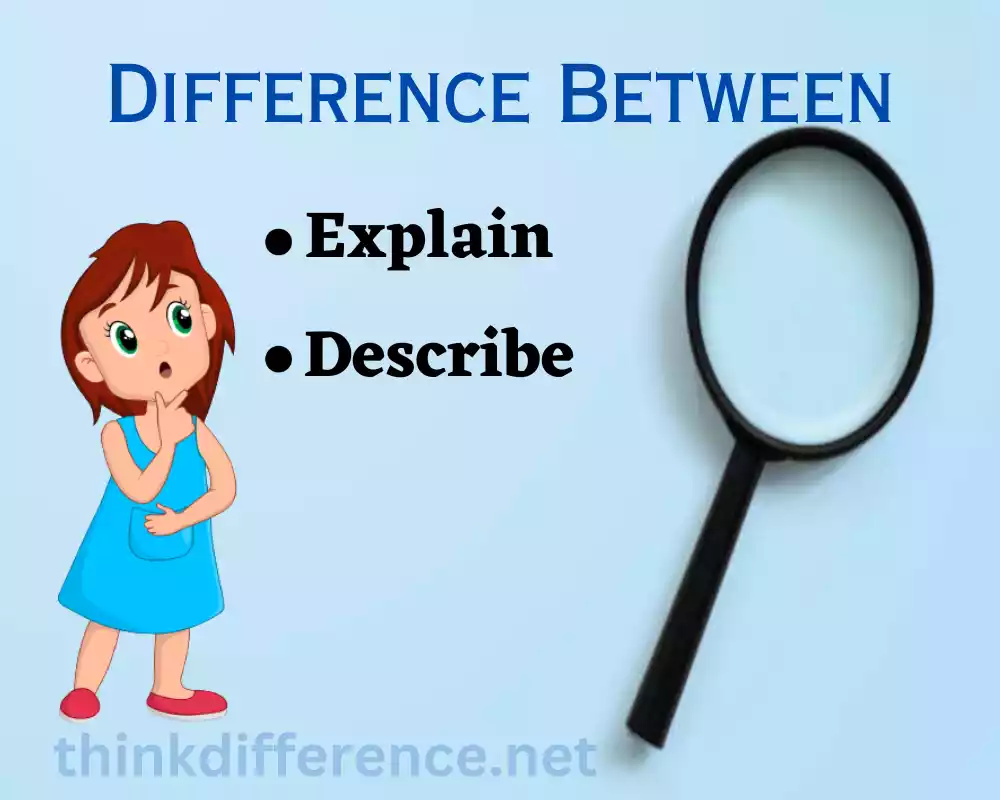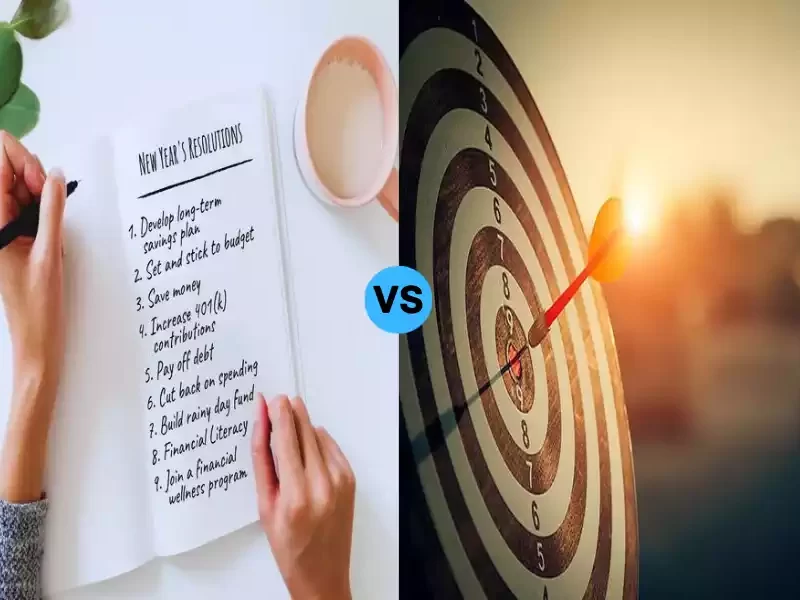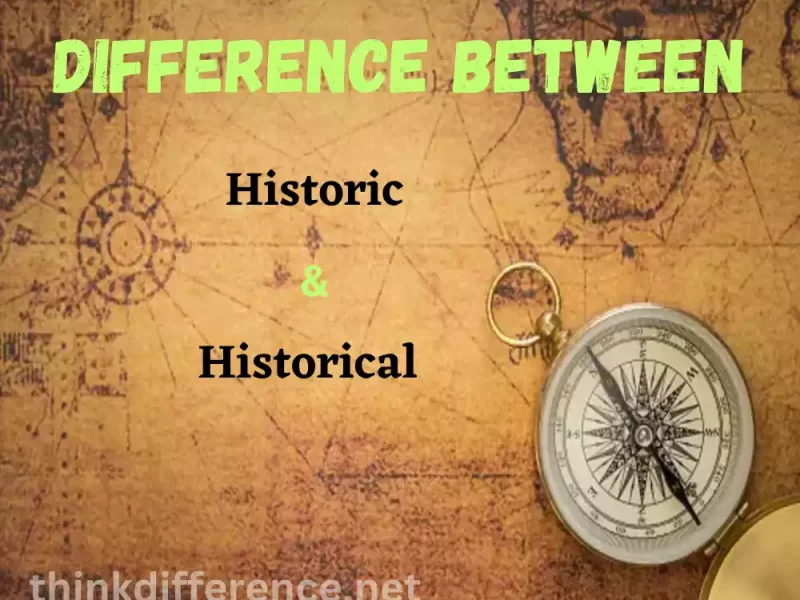Definition of Explain and Describe
Explain: Explaining is the act of making something easily understandable by providing details, information or instructions. Breaking complex ideas down into simpler components for easier consumption. When speaking or lecturing on any given subject or topic, one aims to simplify things for listeners or readers and respond to questions or address comments as soon as they arise.
Answering any queries raised regarding its contents as soon as they appear and explaining its reasoning or providing direction so as to ensure all are fully aware of all available knowledge regarding said matter being covered. Successful explanation relies on succinct words, logic illustrations, examples and images for information transmission within an acceptable format that ensures all parties involved can fully grasp its content and its message without confusion or misinterpretation by means.
Describe: Description is used to express something with precise and vivid language; providing written or verbal reports about qualities, characteristics or experiences which characterise something’s appearance or form. Writing requires using sensory details to evoke an appealing mental picture in the minds of listeners or readers.
Documentaries aim at conveying the essence of individuals, objects or events, scenes or concepts so that viewers may better perceive and comprehend what has occurred or been said or written about it. Effective description uses descriptive adjectives, specific nouns, symbolic language and various literary devices that elicit emotions, stimulate senses and form vivid images within viewers’ minds. The goal of description is to engage and captivate, so viewers experience whatever subject it describes first-hand.
Importance of understanding the difference between Explain and Describe
Understanding the differences between “explain” and “describe” is vital for effective communication and understanding. Both terms refer to conveying information. Their goals and methods vary significantly.
- Precision and Clarity: Differentiating between explain and describe helps in choosing the appropriate method of communication based on the desired outcome. Explanation aims to provide a deeper understanding by breaking down complex ideas into simpler components. Description emphasizes providing vivid and detailed sensory information about a particular subject.
- Contextual Relevance: Recognizing when to explain and when to describe depends on the context and purpose of communication. Explaining is often used in educational or instructional settings, scientific discussions or technical documentation where the goal is to convey knowledge, concepts, or processes. Describing finds its application in creative writing, storytelling, visual arts or capturing sensory experiences.
- Content and Structure: Explaining focuses on conveying the logic, cause-effect relationships, or the step-by-step process involved in a concept. It emphasizes understanding by presenting the underlying principles or mechanisms. Describing is concerned with capturing the visual, auditory or sensory aspects of an object, scene or experience. It aims to provide a detailed portrayal of the appearance, qualities or characteristics.
- Language and Approach: Effective explanation requires using clear and concise language, avoiding ambiguity and presenting information in a logical and systematic manner. It often employs logical reasoning, examples or analogies to aid understanding. Describing employs vivid and sensory language, utilizing adjectives, metaphors or similes to create a sensory-rich experience for the reader or listener.
- Audience Considerations: Understanding the difference between explaining and describing is essential for tailoring your communication to the target audience. Different audiences have varying levels of knowledge and specific preferences. By recognizing the distinction, you can adapt your approach to ensure clarity and engagement.
Grasping the disparity between “explain” and “describe” is vital for effective communication. Both skills have their unique purposes and techniques and being able to differentiate them allows you to convey information accurately, engage your audience and enhance overall communication and comprehension.
Explain
Explaining is the practice of providing details, explanation or clarification regarding an idea, process or relationship. Explanations helps readers or listeners gain a clear and comprehensive knowledge about whatever subject matter needs elucidating. The goal of explanation should be helping readers or listeners comprehend a subject more fully so as to gain greater comprehension in regards to it.
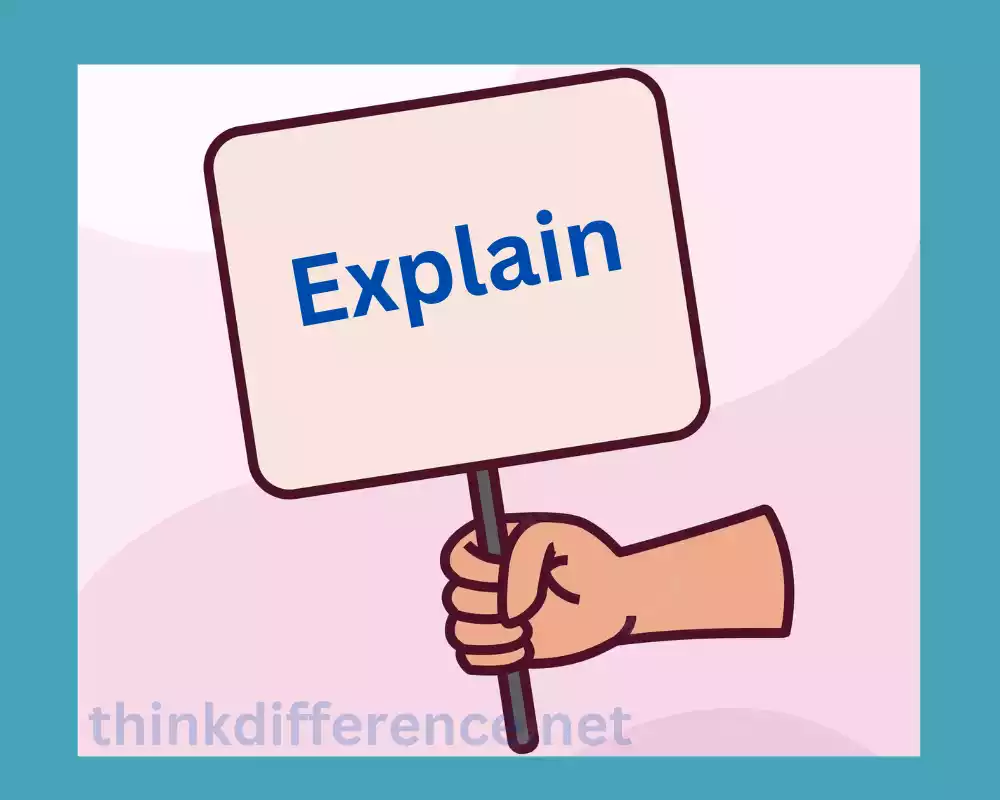
Characteristics of effective explanations include:
- Clarity: Effective explanations are clear and easily understood by the audience. They avoid jargon, complex terminology or ambiguous language, ensuring that the information is conveyed in a straightforward manner.
- Logic and coherence: Explanations follow a logical structure and present information in a coherent sequence. They establish clear connections between ideas, concepts or steps, allowing the audience to follow the reasoning and progression of the explanation.
- Simplicity: Effective explanations strive for simplicity by breaking down complex ideas into manageable parts. They use relatable examples, analogies or visual aids to help illustrate the concepts and make them more accessible to the audience.
- Contextual relevance: Good explanations take into account the audience’s existing knowledge and tailor the information accordingly. They provide the necessary background or context to ensure the audience can understand the explanation within their frame of reference.
- Comprehensiveness: Effective explanations cover the essential aspects of the subject matter without overwhelming the audience with unnecessary details. They strike a balance between providing enough information to grasp the concept while avoiding excessive complexity.
Techniques for providing clear explanations include:
- Use of analogies: Comparing unfamiliar concepts to more familiar ones can help simplify complex ideas and make them easier to understand.
- Visual aids: Diagrams, charts or illustrations can aid in visualizing abstract concepts or processes, enhancing comprehension.
- Step-by-step approach: Dissecting complex ideas into simpler pieces is often necessary in order to make them easily comprehensible and digestible for audiences of any background or education.
- Providing examples: Concrete examples help illustrate the application or relevance of the concept, making it more tangible and relatable to the audience.
- Encouraging questions: Inviting questions from the audience promotes engagement and allows for clarification, ensuring that the explanation is understood.
Explaining is a valuable communication skill that plays a vital role in education, science, technical fields and everyday conversations. It enables effective knowledge transfer and promotes a deeper understanding of various subjects and phenomena.
Describe
Describing involves portraying or representing something through detailed language, sensory observations or visual depiction. It aims to create a vivid and accurate depiction of an object, scene, person or experience, enabling the audience to visualize or imagine it.
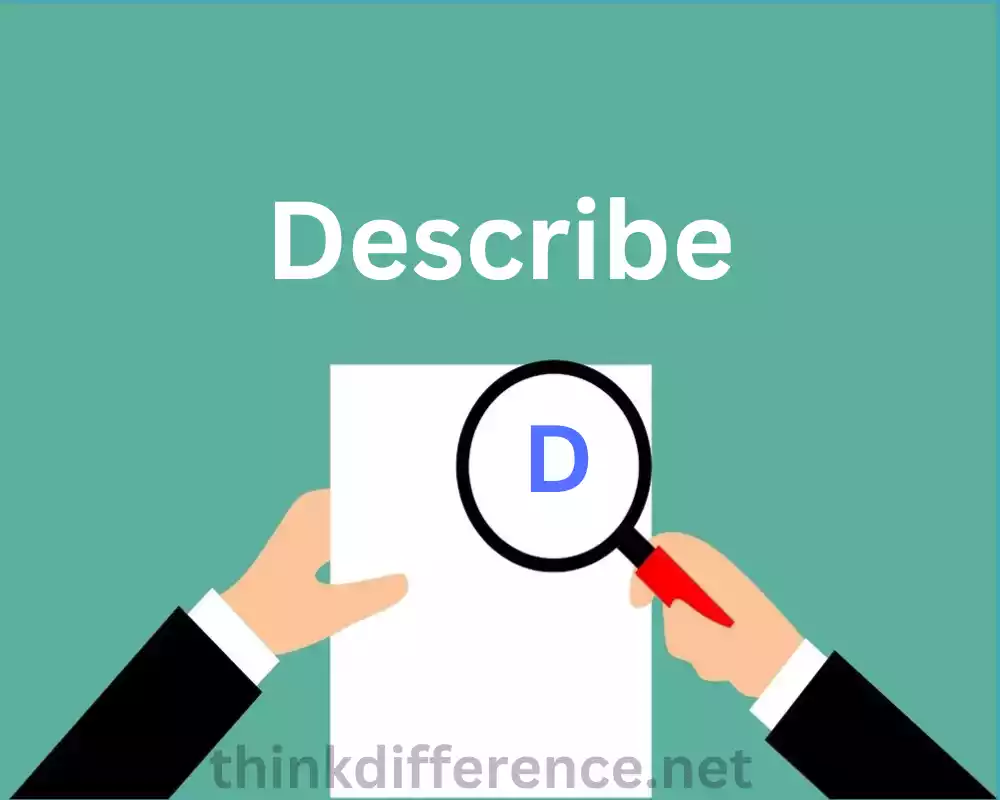
Characteristics of effective descriptions include:
- Detail: Effective descriptions provide specific details that paint a clear picture in the audience’s mind. They include sensory information such as colors, shapes, textures, sounds, smells and tastes, enhancing the audience’s sensory experience.
- Vivid language: Descriptions use expressive and evocative language to engage the audience’s imagination. They employ adjectives, adverbs, metaphors, similes and other figurative language devices to create a rich and immersive sensory experience.
- Organization: Well-crafted descriptions have a logical and organized structure. They may follow a spatial or chronological order, moving from one detail to another in a coherent and meaningful way.
- Subjective perspective: Descriptions can be influenced by the author’s or narrator’s personal experiences, emotions or perceptions. They may incorporate subjective elements to evoke a particular mood or atmosphere.
- Purposeful selection: Effective descriptions select relevant and significant details that contribute to the overall understanding or impression of the subject. They focus on capturing the essence or key qualities of the object or scene being described.
Techniques for providing detailed descriptions include:
- Observation: Close observation of the subject matter is essential for capturing its characteristics accurately. Paying attention to details and taking note of sensory perceptions can enhance the descriptive quality of the writing.
- Use of figurative language: Metaphors, similes and other figures of speech can add depth and richness to descriptions by drawing comparisons and creating associations with familiar objects or experiences.
- Show, don’t tell: Instead of simply stating facts or qualities, effective descriptions engage the audience’s imagination by using specific details and sensory imagery to “show” the scene or object.
- Engaging multiple senses: Descriptions that combine information from multiple senses – sight hearing sight, touch smell taste – provide viewers with an immersive experience and foster greater engagement with the subject matter.
- Revision and editing: Refining and revising descriptions is crucial to ensure clarity, coherence and impact. Editing allows for the elimination of unnecessary or redundant details and the refinement of language and structure.
Describing is a valuable skill used in creative writing, literature, poetry, travel writing, visual arts and other forms of expression. It enables the audience to experience a subject vicariously, bringing it to life through words and imagery.
Differences between Explain and Describe
Explain and describe are words with distinct meanings and purposes that each carry distinct associations for content, language and context. Here are the major distinctions between describe and explain:
1. Focus and Objective:
- Explain: To provide clarity, information or clarification regarding any process, concept or connection. Explanations is intended to break complex ideas down into smaller components that can be presented logically and concisely for effective understanding and presentation.
- Description: Depiction or description involves accurately portraying something using explicit language, sensory observations and visual depiction to enable viewers to visualize an experience or event visually. This allows viewers to engage more fully in what’s being described to them and visualize an accurate depiction.
2. Content and Structure:
- Explain: Explanation involves conveying concepts, processes, mechanisms or cause-effect relationships. It breaks down a subject into logical steps, principles or components to aid understanding.
- Describe: Description involves portraying visual or sensory details of a subject, such as its appearance, qualities, characteristics or sensory experiences. It focuses on capturing the sensory aspects, emotions or atmosphere surrounding the subject.
3. Language and Approach:
- Explain: Explanation utilizes clear and concise language, emphasizing cause-effect relationships, logical reasoning or the use of examples and analogies to aid understanding. It aims to present information in a systematic and logical manner.
- Describe: Description employs vivid and sensory language, utilizing adjectives, adverbs, metaphors, similes and other figurative language devices to create a sensory-rich experience. It focuses on evoking the senses and creating a visual or sensory image for the audience.
4. Context and Audience:
- Explain: Explanation is often used in educational or instructional settings, scientific discussions, technical documentation or when conveying complex ideas or processes to an audience seeking understanding.
- Describe: Description finds its application in creative writing, literature, poetry, travel writing, visual arts or when capturing sensory experiences. It appeals to the imagination and emotions of the audience.
Understanding these differences is crucial for effective communication. By recognizing the distinction between explaining and describing, you can choose the appropriate approach to convey information accurately, engage your audience and enhance communication and comprehension.
Ways to Effectively Explain and Describe
To effectively explain and describe, consider employing the following techniques:
Effective Explanation:
- Start with a clear and concise statement of the main idea or concept.
- Break down complex ideas into simpler components or steps.
- Use logical reasoning and provide supporting evidence or examples.
- Use relatable analogies or metaphors to make the concept more understandable.
- Anticipate and address potential questions or misunderstandings.
- Use visuals, diagrams or charts to aid understanding, if applicable.
- Check for understanding by encouraging questions and feedback from the audience.
- Summarize and reinforce the main points at the end of the explanation.
Effective Description:
- Observe and gather specific details about the subject using all the senses.
- Use vivid and sensory language to create a clear mental image.
- Include relevant and significant details that contribute to the overall impression.
- Utilize descriptive adjectives, adverbs and figurative language to enhance the description.
- Organize the description in a logical and coherent manner, following a spatial or chronological order.
- Show, rather than tell, by providing sensory details and allowing the reader to form their own mental image.
- Use comparisons or analogies to evoke emotions or convey specific qualities.
- Revise and edit the description to ensure clarity, coherence and impact.
Remember, effective explanation focuses on providing understanding and clarity through logical and concise language, while effective description aims to create vivid and sensory-rich portrayals through detailed observations and engaging language. Both techniques can benefit from practice, feedback and a deep understanding of the subject matter or the experience being conveyed.
Common Mistakes to Avoid
As part of your communication efforts when explaining or detailing a process, it’s crucial that you keep an eye out for common blunders that could impede its effectiveness – these being among the top mistakes:
- Lack of clarity: Avoid using ambiguous language or jargon that may confuse or alienate your audience. Strive for clarity by using straightforward and concise language.
- Overuse of technical terms: While it’s important to provide accurate information, be mindful of your audience’s level of familiarity with technical terms. Use plain language and provide explanations or definitions for complex terms when necessary.
- Lack of organization: Ensure that your explanation or description follows a logical and organized structure. Present information in a coherent manner, using clear transitions between ideas or details.
- Insufficient detail: Avoid being too vague or providing incomplete information. Include enough specific details to allow your audience to fully grasp the subject matter or visualize the scene you are describing.
- Overwhelming with details: Be cautious not to overwhelm your audience with an excessive amount of unnecessary details. Focus on the key points or essential aspects that contribute to the overall understanding or impression.
- Neglecting the audience’s perspective: Consider your audience’s background knowledge, experiences and level of understanding. Tailor your explanation or description to meet their needs and provide the necessary context for comprehension.
- Lack of engagement: Make your explanation or description engaging by using appropriate examples, analogies or stories that resonate with your audience. Foster a connection and maintain their interest throughout.
- Ignoring feedback: If you have the opportunity to receive feedback or questions from your audience, pay attention to it. Address any misunderstandings, clarify uncertainties or provide additional information as needed.
- Neglecting revision and editing: Take the time to revise and edit your explanation or description. Look for areas of improvement, such as clarity, coherence and impact. Eliminate any unnecessary repetition or redundant information.
By avoiding these common mistakes, you can enhance the effectiveness of your explanations and descriptions, ensuring that your audience gains a clear understanding or vivid visualization of the subject matter.
Tips for Improving Explain and Describe
To improve your skills in explanation and description, consider the following tips:
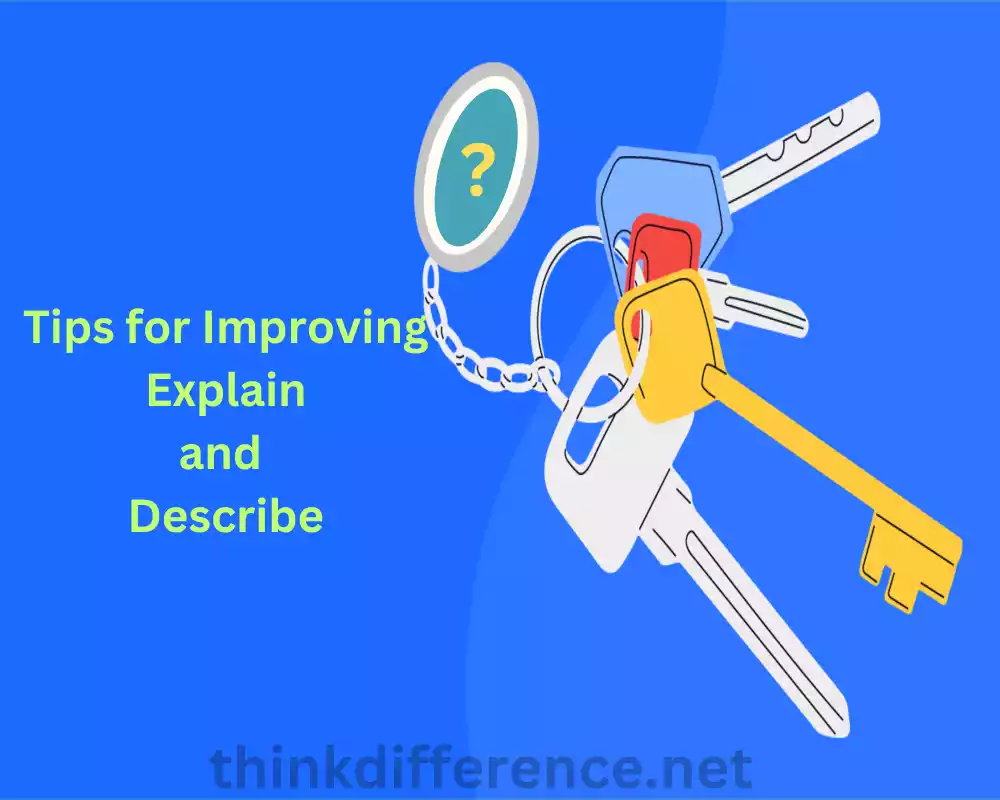
- Practice active observation: Develop your observation skills by paying attention to details in your surroundings. Notice the colors, shapes, textures, sounds, smells and other sensory elements. This will enhance your ability to provide rich descriptions.
- Read and analyze examples: Read various examples of effective explanations and descriptions across different genres. Analyze how authors use language, structure and sensory details to engage the reader. Take note of techniques you can incorporate into your own writing.
- Use concrete and specific language: Instead of using vague or generic terms, be specific in your language. Use precise nouns, descriptive adjectives and vivid verbs to paint a clear picture or convey information accurately.
- Engage the senses: Tap into the power of sensory language to bring your descriptions to life. Incorporate vivid descriptions that appeal to sight, hearing, touch, smell and taste. This will help the reader or listener immerse themselves in the experience.
- Seek feedback: Share your explanations and descriptions with others and ask for constructive feedback. Listen to their perspectives and suggestions for improvement. This feedback can help you identify areas where you can enhance your clarity, organization or language usage.
- Use storytelling techniques: Storytelling elements can make your explanations and descriptions more engaging. Incorporate narrative elements such as plot, character, conflict and resolution to create a captivating experience for your audience.
- Adapt to your audience: Tailor your explanations and descriptions to suit your audience’s background, knowledge and interests. Adjust your language, examples and level of detail accordingly to ensure maximum comprehension and engagement.
- Edit and revise: Take the time to review and edit your work. Check for clarity, coherence and flow. Eliminate unnecessary or repetitive information and refine your language to make your explanations and descriptions more impactful.
- Practice brevity: Strive to communicate your ideas concisely and efficiently. Avoid unnecessary wordiness or excessive details that may detract from the main message or dilute the impact of your descriptions.
- Read aloud: Reading your explanations and descriptions aloud can help you identify areas that may need improvement. It allows you to assess the flow of your language, identify awkward phrasing and ensure that your words create the intended impact.
By implementing these tips and consistently practicing your explanation and description skills, you can enhance your ability to effectively convey information and create vivid, engaging portrayals.
Conclusion
The ability to “Explain and Describe” is an essential skill that has far-reaching impacts in various aspects of life. Clear communication fosters understanding, bridges gaps, and enriches human connections. By mastering the art of explanation and description, we can unlock a world of possibilities in education, business, and creative endeavors.

